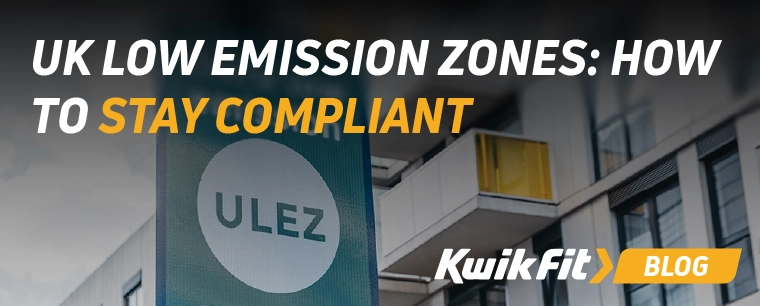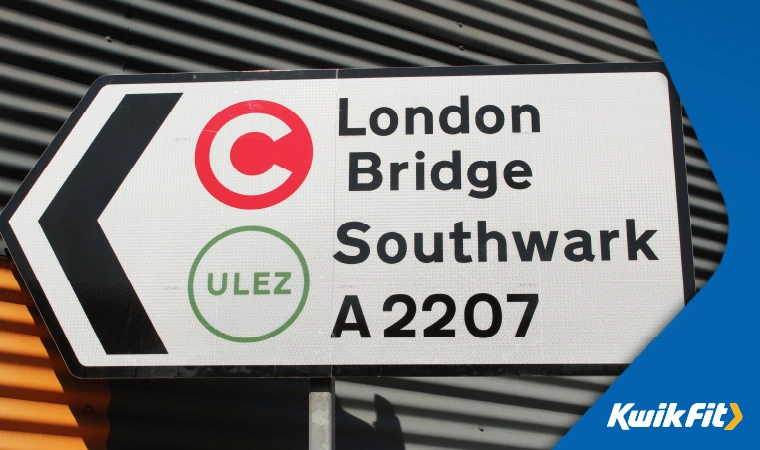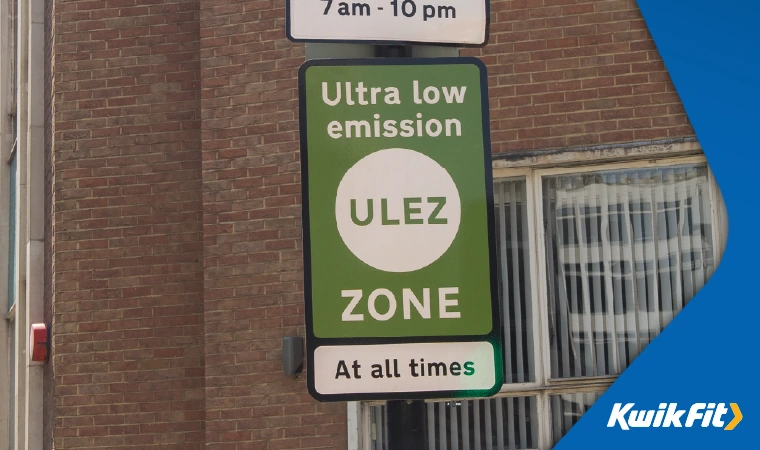UK Low Emission Zones: How to Stay Compliant
Jack Dreyer | Thursday 22nd August 2024 8:00am

According to This is Money, local councils across the UK have generated significant revenue from emission zone penalty charges, reflecting the growing implementation of Low Emission Zones (LEZ) and Ultra-Low Emission Zones (ULEZ). These initiatives have garnered considerable public interest, with varied perspectives on their impact and effectiveness.
We’ve spoken about London’s emissions regulations in a previous blog, so we’re expanding our focus to the other Low Emission Zones around the country and their financial implications for drivers.
Read on to learn more about emission zone compliance and its broader effects.
Where are the Low Emission Zones in the UK?
There are currently 15 cities with Low Emission Zones around the country. These zones each have slightly different names and specifications and can be called:
- LEZ (Low Emission Zones)
- ULEZ (Ultra-Low Emission Zones)
- and CAZ (Clean Air Zones).
However, regardless of the name, they all function as boundaries implemented in particular areas of a city, usually the centre, to limit the number of older and higher-polluting vehicles in that zone with the aim of improving air quality.
The cities which currently have either CAZ, LEZ or ULEZ are as follows: London, Portsmouth, Bath, Bristol, Oxford, Birmingham, Sheffield, Bradford, Newcastle upon Tyne, Edinburgh, Glasgow, Dundee, and Aberdeen.
Below, we’ve gone into more detail about London, Birmingham, and Bristol’s Low Emission Zones as these are the cities that ‘earn’ the most from emissions taxes.
London’s ULEZ history
Originally, London only had a Congestion Charge Zone (CCZ) in the centre of the city which then expanded into a Low Emission Zone and later, the Ultra-Low Emission Zone which had a boundary expansion in 2021 and again in 2023.
From the 8th of April 2019, drivers with diesel cars that fail to adhere to Euro 6 emissions standards (usually cars registered from 2016) and petrol cars which fail to meet Euro 4 (cars usually registered from 2006) have to pay £12.50 a day to enter the ULEZ. That includes the £15 a day for entering the CCZ, which means you would have to pay a total of £27.50 a day if you don’t meet the requirements. ULEZ is in effect 24 hours a day, 365 days a year, therefore, driving a non-compliant car into ULEZ just once a week will make up a £650 annual tax bill.
London generates an average of £12.5 million a month from ULEZ and CCZ charges, meaning it makes the most money out of any other of the LEZ cities. The Mayor of London’s office argues that this money will be reinvested into better transport for London and that, as cars become more compliant, the number of vehicles being charged will go down. This reduction may even drop to £0 after the ban on the production of combustion engine vehicles between 2030 to 2040.
Birmingham
Birmingham has a tax type known as CAZ D. This tax type means that buses, coaches, taxis, PHVs, HGVs, LGVs, and car drivers who do not meet the Euro 6 and Euro 4 emissions standards will all be charged £8 a day. Birmingham, on average, makes a monthly income of £3.6 million from this tax, making a staggering total of £125 million since June 2021.
Bristol
Bristol’s Clean Air Zone started in 2022, but it has already amassed the third-highest monthly revenue of £2.2 million. It has the same CAZ D system as Birmingham, and drivers aren’t banned from the centre but do have to pay £9 a day.

The financial impact of Low Emission Zones
As you’ve seen from the top three cities based on earnings from emissions charges above, the incentives clearly work well for council coffers, and London, Birmingham and Bristol are all raking in multi-million pound incomes every month from both standard charges and PCNs (penalty charge notices) from the failure to pay within the allowed timeframe.
PCNs are really where we see the biggest financial impact, and reports show the number of bailiffs sent to motorists’ homes to enforce PCNs has doubled since the pandemic.
The PCN debate
There is a fierce debate around this issue, with one side claiming that motorists are more careless and even more ‘selfish’ since the pandemic, and the other side saying that, much like with PCNs which were issued over parking during the early 2000s, councils make rules obscure or set up junctions, emission zones, and bus lanes to be ‘cash boxes’ to squeeze money out of motorists.
Regardless, the best way to keep the bailiffs at bay, to avoid court, and to stop a small charge from becoming a very large fine, is to keep yourself informed on the rules, know the boundaries and pay up when you’re expected to.
How to stay compliant and avoid penalty charges
One of the best ways to stay compliant is to keep up to date with each city’s boundaries and rules. When you know you’re going to be driving into a city, ask yourself if you need to drive into the centre and, if you do, then are you prepared to pay any charge? Is your vehicle compliant?
Below, we’ll take you through the different cities’ emission rules and charges for cars — in price order— to use as a guide when you’re planning your next city trip.
Free (for cars)
Bath
Bath’s emissions tax was the first one introduced outside of London, but notably does not charge car drivers. Enforced since the 15th of March 2021, this CAZ C tax type applies to buses, coaches, taxis, PHVs, HGVs, and LGVs. For vans, the cost is £9 a day (or £3,285 per year if driving in the zone daily).
Portsmouth
Portsmouth has a Clean Air Zone for incoming vehicles, but not car or van drivers. Active since the 29th of November 2021, this CAZ B tax charges incoming buses, coaches, taxis, PHVs, and HGVs.
Bradford
Bradford has a Clean Air Zone that does not charge car drivers, only drivers of larger vehicles. Active from the 26th of September 2022, this CAZ C tax will cost nothing for car drivers but £9 a day for private van drivers. Charges will also apply to buses, coaches, taxis, PHVs, HGVs, and LGVs.
Newcastle upon Tyne
There are Clean Air Zones in Newcastle city centre, Gateshead, and North Tyneside, but no charge for car drivers — only larger vehicles. Since the 30th of January 2023, this CAZ C tax has been charging vans £12.50 a day, totalling £4,562.50 a year if driving in the zone daily!
Sheffield
Sheffield has an inner-city Clean Air Zone targeted at the dirtiest vehicles - but, again, not cars. Since the 27th of February 2023, Sheffield Council has been charging vans £10 a day (or £3,650 per year if driving in the zone daily). The charges also apply to buses, coaches, taxis, PHVs, HGVs, and LGVs but at different rates.
Minimum £2 charge per day
Oxford
Oxford has the first Zero Emission Zone that charges every vehicle apart from electric ones. The pilot scheme was launched on the 28th of February 2022 and impacted 8 central city streets. All vans and cars that are petrol, diesel, and hybrid will be charged a minimum of £2 a day. Depending on vehicle emissions, this charge may reach a maximum of £10 a day, totalling £3,650 a year if driving in the zone daily.
£8 charge per day
Birmingham
In operation since the 1st of June 2021, Birmingham’s CAZ D emissions tax is a daily charge for drivers of older petrol and diesel cars to enter the limits of the city ring road. For cars and vans, the charge is an £8 daily charge if a diesel car isn't Euro 6 or petrol isn't at least Euro 4 (£2,920 per year if driving in the zone daily). The charge also applies to Buses, coaches, taxis, PHVs, HGVs, and LGVs.
£9 per day
Bristol
Active since the 28th of November 2022, Bristol’s Clean Air Zone (CAZ D) charges drivers of older passenger cars, buses, coaches, taxis, PHVs, HGVs, and LGVs. For cars and vans, Bristol’s Clean Air Zone will charge £9 per day if a diesel vehicle isn't Euro 6 or petrol isn't at least Euro 4, totalling £3,285 per year if driving in the zone daily.
£12.50 per day
London
For car drivers, London is the most expensive Low Emission Zone area in the country. After its most recent expansion on the 29th of August 2023, all 32 London boroughs are affected. For cars and private vans, there is a £12,50 daily charge if a diesel isn't Euro 6 or petrol isn't at least Euro 4. In total, this adds up to £4,562.50 per year if driving in the zone daily. While black cabs are exempt, buses, coaches, other taxis, PHVs, HGVs, and LGVs also have separate charges.
Bans, not fines
For some areas, like in Scotland, there aren’t emissions charges — but outright bans. In parts of Dundee, Edinburgh, Glasgow, and Aberdeen, vehicles that aren’t compliant will receive a PCN even if they enter the designated Low Emission Zone.
Dundee
Since the 30th of May 2024, the area inside the A991 inner ring road ( excluding the Bell Street, West Marketgait NCP, and Wellgate car parks) has had a ban on non-compliant vehicles with high emissions. This is in place 24 hours a day, year-round. However, Blue Badge holders are excluded if they register their details.
Edinburgh
From the 1st of June 2024, Edinburgh’s LEZ boundary has circled the city centre. While all vehicles may drive around the boundary (including non-compliant ones), enforcement only takes place within the zone itself and is in operation 365 days a year. As with Dundee, Blue Badge holders are exempt.
Glasgow
Glasgow’s Low Emission Zone has been enforced since the 1st of June 2023, but residents were given a 12-month grace period prior to this. Now, the restriction applies to one square mile covering the city centre (excluding the M8 motorway). The same exemptions as above apply here.
Aberdeen
Lastly, Aberdeen joins the rest of the Scottish cities in emissions restrictions, beginning on the 1st of June 2024. With a slightly more complicated boundary, Aberdeen’s impacted areas stretch from Skene Street to Holburn Street to Little John Street. The exclusions include Blue Badge holders, disabled passenger vehicles, historic vehicles, showman's vehicles, emergency vehicles, and military vehicles.
What’s more, Aberdeen City Council can grant additional time-limited exemptions for certain specialist vehicles which are not suitable for replacement or retrofit - email application information here.
Scottish LEZ support schemes
There are support schemes — like the Low Emission Zone Support Fund — which are available to drivers across Scotland who need to retrofit or change their vehicles. If this applies to you, you can apply via the Low Emission Zone Support Fund. Under this scheme, a £2,000 grant is available to eligible households who dispose of their non-compliant vehicle at a Scottish-authorised treatment facility. Similarly, Travel Better grants of up to £500 are also available for each adult in your household. A maximum of £1,000 per household applies.

Is your car LEZ-compliant?
If you want to find out more about your car and whether it is compliant, then why not bring it to your nearest Kwik Fit centre for a check-up? We can also let you know if your car may be facing any problems which are making it more polluting. Bring your vehicle in for a free health check and we’ll alert you of any serious issues or small fixes which could improve the efficiency of your car.
The best way to keep yourself from getting surprise fines is by staying on top of changes to the law and maintaining your vehicle. So, come on in for a service and stay compliant.
Any facts, figures and prices shown in our blog articles are correct at time of publication.
Featured Articles
Is it Illegal to Drive With One Headlight?
Saturday 19th July 2025
Wondering if it’s illegal to drive with one headlight? Learn about the safety risks and penalties of illegal blown bulbs and why you should fix them promptly.
Air Con in EVs & Hybrids: Experts Answer Your Questions
Monday 30th June 2025
Does air con drain EV batteries? Can you use the air con while charging an electric car? Find out the answers to these questions & more from Kwik Fit’s experts.
Why Is Your Car Making a Noise? Fixes & Tips
Friday 13th June 2025
When your car starts making unexpected noises, it can certainly be quite disconcerting; it may be nothing to worry about, but here’s what you need to know.









